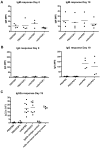A targeted complement-dependent strategy to improve the outcome of mAb therapy, and characterization in a murine model of metastatic cancer
- PMID: 22442351
- PMCID: PMC3383016
- DOI: 10.1182/blood-2011-10-383232
A targeted complement-dependent strategy to improve the outcome of mAb therapy, and characterization in a murine model of metastatic cancer
Abstract
Complement inhibitors expressed on tumor cells provide an evasion mechanism against mAb therapy and may modulate the development of an acquired antitumor immune response. Here we investigate a strategy to amplify mAb-targeted complement activation on a tumor cell, independent of a requirement to target and block complement inhibitor expression or function, which is difficult to achieve in vivo. We constructed a murine fusion protein, CR2Fc, and demonstrated that the protein targets to C3 activation products deposited on a tumor cell by a specific mAb, and amplifies mAb-dependent complement activation and tumor cell lysis in vitro. In syngeneic models of metastatic lymphoma (EL4) and melanoma (B16), CR2Fc significantly enhanced the outcome of mAb therapy. Subsequent studies using the EL4 model with various genetically modified mice and macrophage-depleted mice revealed that CR2Fc enhanced the therapeutic effect of mAb therapy via both macrophage-dependent FcγR-mediated antibody-dependent cellular cytotoxicity, and by direct complement-mediated lysis. Complement activation products can also modulate adaptive immunity, but we found no evidence that either mAb or CR2Fc treatment had any effect on an antitumor humoral or cellular immune response. CR2Fc represents a potential adjuvant treatment to increase the effectiveness of mAb therapy of cancer.
Figures







Comment in
-
Boosting antibody therapy with complement.Blood. 2012 Jun 21;119(25):5945-7. doi: 10.1182/blood-2012-04-420760. Blood. 2012. PMID: 22730521
References
-
- Gelderman KA, Tomlinson S, Ross GD, Gorter A. Complement function in mAb-mediated cancer immunotherapy. Trends Immunol. 2004;25(3):158–164. - PubMed
-
- Heeger PS, Kemper C. Novel roles of complement in T effector cell regulation. Immunobiology. 2012;217(2):216–224. - PubMed
-
- Kemper C, Atkinson JP. T-cell regulation: with complements from innate immunity. Nat Rev Immunol. 2007;7(1):9–18. - PubMed
Publication types
MeSH terms
Substances
Grants and funding
LinkOut - more resources
Full Text Sources
Other Literature Sources
Molecular Biology Databases
Miscellaneous

